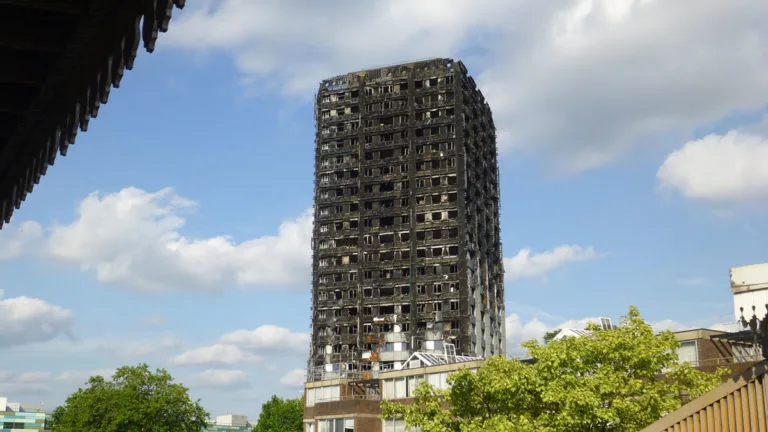Unsafe cladding: we’ve made progress, but our campaign isn’t over
Published: by Hannah Rich

Our campaign
One year on after Grenfell, only 4% of the 158 social housing tower blocks with the same cladding have had it removed and replaced. In March 2018, we launched our campaign urging the government to step up and make sure these homes are safe. We asked the government to do three things:
- provide essential emergency funding to cover the costs of removing and replacing unsafe cladding for social landlords
- provide guidance on which materials are safe to use in place of the unsafe cladding
- provide guidance on the appropriate timeframe for making buildings safe
As part of this campaign, we carried out an investigation with social landlords to find out how much they’re spending on interim fire safety measures, to understand the causes of delays to remedial works (the removal and replacement of unsafe cladding) – and to explore the impact of these works on other spending.
What has changed in the last two weeks?
On 16 May, the government announced £400 million for local authorities and housing associations, to ‘fully fund’ the removal and replacement of aluminium composite material (ACM) cladding on social housing buildings over 18 metres tall. This was the type of cladding used on Grenfell Tower.
Since then, Housing Secretary James Brokenshire said the government will launch a consultation into a potential ban on combustible cladding – despite the fact that the Hackitt Review into building safety regulations didn’t explicitly recommend a legal ban on combustible materials. A ban would provide much clearer guidance on what cladding is safe to use.
These announcements are great news for our campaign and more importantly, the social tenants who live in high-rise buildings with unsafe cladding.
The possibility of continued delays
Despite these huge successes, there are still some uncertainties.
We don’t know when social landlords will receive the money. This could further delay remedial works, forcing councils and housing associations to keep spending money on interim fire safety measures (put in place to keep affected residents safe).
Interim measures can include things like 24/7 fire wardens, temporary fire alarm systems, and fire risk assessments. We undertook an investigation using Freedom of Information (FOI) data and surveys. This found that since June 2017, 15 social landlords have spent over £10 million on interim fire safety measures. This works out at over £840,000 per social landlord.
We also wanted to understand the causes of the delays – and found that one of the key barriers to completing remedial works is uncertainty around what materials are safe to use. While we welcome the announcement of the consultation into combustible materials, this is by no means a done deal.
Other key barriers include the shortage of materials, and qualified professionals. These are difficult issues to resolve, but it’s clear that the cladding crisis will not be fixed solely by investment.
Impact of remedial works on social landlords’ spending
Our investigation also revealed that the costs of removing and replacing cladding are eating up so much of their budgets that social housing providers are cutting back on other much-needed housing work. Councils and housing associations told us that there is less money available for building homes, and refurbishing/maintaining existing homes.
In a letter to housing associations, James Brokenshire said that the £400 million funding will be ‘available regardless of whether work has been started, completed or not yet started’. This is welcome news for social landlords who have completed works, and had to make cuts to other vital spending. We must make sure that the government follows through on this promise.
What’s next for our campaign?
Remedial works to remove and replace unsafe cladding have been mired in delays and confusion. This has resulted in social landlords spending millions on interim fire safety measures to ensure that residents are safe in their homes. For those housing providers that have completed remedial works, they are likely to have had a significant impact on other vital areas of spending on housing.
We will keep campaigning to ensure that the promised funding is provided as quickly as possible, to avoid further delays – and that it goes to the social landlords most in need, even if they have already completed works. We will also continue to put pressure on the government to provide guidance on what materials are safe to use, by banning all combustible materials.
Our end goal is for the 158 affected social housing buildings to have removed and replaced Grenfell-style cladding. We’re not there yet, but we’re moving in the right direction.
Photo credit: By PaulSHird (https://www.flickr.com/photos/paulhird/35374233943)